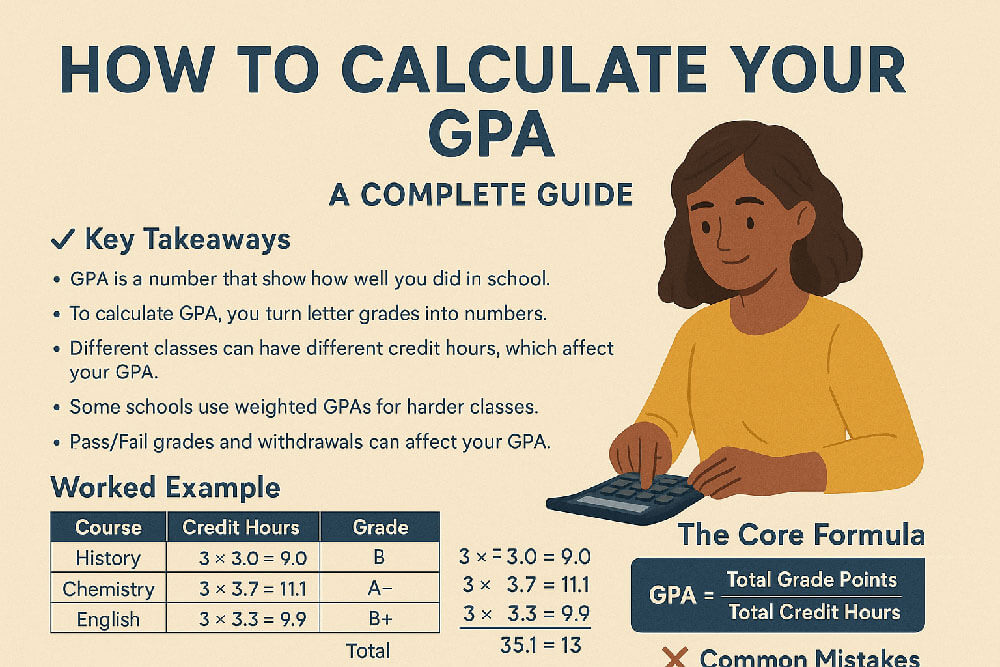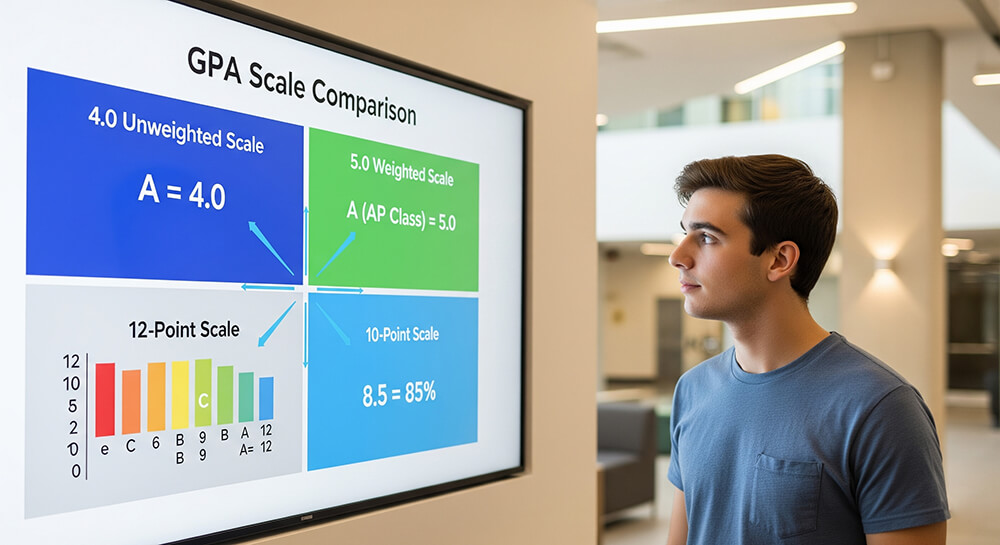Key Takeaways
- The 2.0 GPA Standard: The vast majority of American universities consider a 2.0 cumulative GPA the minimum for good academic standing. Falling below this number often triggers a warning or probation.
- Warning vs. Probation: Many schools use a two-step system. An "academic warning" is often the first notice, while "academic probation" is a more serious status that can restrict enrollment and affect financial aid.
- Financial Aid is at Risk: Students on academic probation can lose eligibility for federal and state financial aid, making it harder to pay for the classes needed to raise their GPA.
- State Rules Vary: While the 2.0 GPA threshold is nearly universal, the specific rules for probation, suspension, and getting back into good standing differ from state to state and school to school.
- Honors and Recognition: Achieving a high GPA opens doors to the Dean's List and graduation honors like cum laude. Dean's List often requires a semester GPA of 3.5 or higher, while graduation honors typically start at a 3.5 cumulative GPA.
- A Shift in Language: Many universities are replacing the term "academic probation" with "academic notice" to reduce stigma and encourage students to seek help.
College is a time of growth and learning. Part of that journey is understanding how schools measure success. Your Grade Point Average, or GPA, is a key number. It tells you and the school how you are doing in your classes. If your GPA drops too low, you might face academic probation. This guide explains the rules so you can stay on track.
Understanding GPA: The First Step to Good Standing
Your GPA is a score for your grades. Most schools in the U.S. use a 4.0 scale. An 'A' is worth 4 points, a 'B' is 3, and so on. To find your GPA, you turn your letter grades into points. You can use a college GPA calculator to make this easy. Knowing how to calculate your GPA is the first step. It helps you see where you stand and what you need to do to improve.
Many students make simple mistakes when figuring out their GPA. Forgetting to include all classes is a common error. A clear understanding of the GPA formula guide helps avoid these problems. This knowledge helps you stay in good academic standing.
Different GPA Scales: From 4.0 to 5.0
Not all schools use the same GPA scale. The most common is the unweighted 4.0 scale. However, some high schools use a weighted GPA. This means they give extra points for harder classes, like Advanced Placement (AP) or Honors courses. This can lead to a GPA higher than 4.0, sometimes on a 5.0 GPA scale.
It is important to know the types of GPA scales your school uses. This knowledge helps you understand your transcript and academic standing. A GPA scale comparison can show you how different systems measure your hard work.
The 2.0 GPA Rule: A Nationwide Standard
Across the United States, there is a common rule. Most colleges and universities require a minimum 2.0 cumulative GPA to stay in good academic standing. This is like getting a 'C' average in all your classes. This standard is very consistent, from California to New York. Out of 44 universities studied, 43 of them use this 2.0 threshold.
Falling below this 2.0 mark puts a student at risk. The school will place them on academic probation. This consistency gives students a clear and predictable goal. You can track your progress each term with a semester GPA calculator to ensure you stay above this important number.
Academic Warning vs. Probation: What's the Difference?
Many schools have a two-tier system to help struggling students. The first step is often an "academic warning." This happens if your GPA drops below 2.0 for the first time. It is a signal to seek help and improve your grades. For example, some schools issue a warning if a student's GPA is between 2.0 and 2.25.
If grades do not improve, the next step is "academic probation." This is a more serious status. It might mean you can take fewer classes. It also puts your financial aid at risk. Dealing with incomplete grades can be tricky, so it's vital to have a plan. Using an incomplete grades scenario planner can help you see how missing work affects your standing.
How Probation Rules Change by State
While the 2.0 GPA standard is widespread, the details of probation policies can change by state and even by school.
- California: The University of California system now uses the term "academic notice" instead of "probation" to be more supportive. California State Long Beach requires a 2.0 for undergraduates but a 3.0 for graduate students.
- Texas: At Texas A&M, a GPA below 2.0 in your major can also lead to probation. Texas State gives students on probation a chance to stay enrolled if they earn at least a 2.25 semester GPA.
- Florida: The University of West Florida has a graduated GPA standard for new students, requiring a GPA between 1.6 and 1.99 depending on credits.
- New York: CUNY Law School is an exception to the rule, requiring a higher 2.5 GPA for good standing.
- North Carolina: UNC Greensboro requires students on probation to earn a 2.30 term GPA and may make them take an academic recovery class.
- Ohio: Ohio State requires students on probation to meet with an academic advisor and may limit the number of classes they can take.
Understanding how school districts calculate GPA can provide more context for these different rules.
A Plan to Get Off Academic Probation
Getting a notice of academic probation can be scary, but it is not the end. It is a chance to make a change. The first step is to talk to your academic advisor. They can help you make a plan. This plan might include taking fewer classes to focus more on each one.
You should also use campus resources. Tutoring centers, writing labs, and counseling services are there to help you succeed. Developing better study tips for better grades is crucial. If you have failed a class, look into your school's policy on retaking it. A repeat course GPA recalculator can show you how a better grade can boost your GPA.
Aiming High: Dean's List and Graduation Honors
Staying in good academic standing is the first goal. The next is to excel. Schools recognize top students with special honors. The Dean's List is a semester award for students with a high GPA, usually 3.5 or higher. Some elite schools give this honor to the top 10% or 25% of students in a college. A Dean's List eligibility checker can help you see if you qualify.
Graduation honors, also known as Latin honors, are the highest form of recognition. There are three levels:
- Cum Laude (with praise): Usually a GPA of 3.5–3.7.
- Magna Cum Laude (with great praise): Typically a GPA of 3.7–3.9.
- Summa Cum Laude (with highest praise): A GPA of 3.9 or higher.
These honors look great on a resume and for graduate school applications.
Special Cases: Transfer and International Student GPAs
The rules for academic standing can be different for students coming from other places. If you are a transfer student, it is important to see how your credits will move to your new school. A transfer credits GPA integrator can help you understand how your previous grades will affect your new GPA.
International students face unique challenges. Their home country's grading system might be very different from the U.S. 4.0 scale. For example, converting grades from the UK class system or Nigeria's 5-point scale requires special attention. An international GPA converter guide is an essential tool for these students to understand where they stand academically.
Frequently Asked Questions (FAQ)
1. What is the most common GPA for academic probation? Most U.S. universities place students on academic probation if their cumulative GPA falls below 2.0, which is a "C" average.
2. Can I get financial aid while on academic probation? It depends on the school and the type of aid. Many students on academic probation are at risk of losing federal and state financial aid. You must meet Satisfactory Academic Progress (SAP) requirements, which are often similar to good academic standing rules.
3. How is the Dean's List calculated? Dean's List requirements vary. Many schools require a semester GPA of 3.5 or higher while taking a full-time course load (usually 12 credits). Some competitive universities award it to a certain percentage of top-performing students, like the top 10% of their class.
4. What are graduation honors? Graduation honors, or Latin honors, recognize students with a high overall GPA upon graduation. The three main levels are cum laude (top 20-30%), magna cum laude (top 10-15%), and summa cum laude (top 1-5%). The exact GPA cutoffs differ by university.








